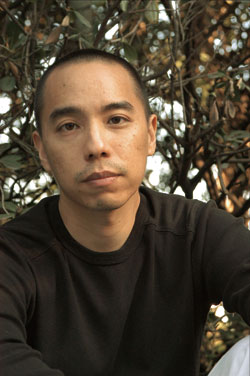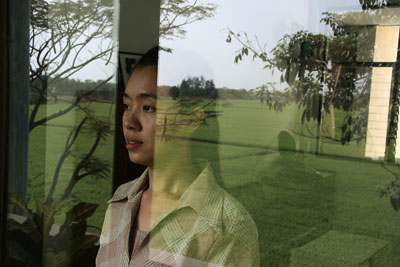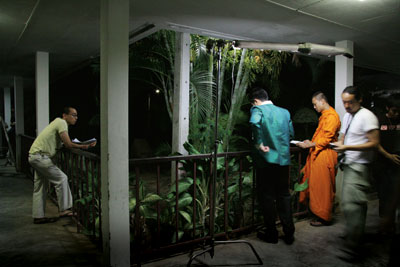
ISAN, OR NORTHEASTERN THAILAND, is a region known among Thais mainly for its poverty and grim heat—in contrast with the idyllic beaches of the south or the temperate hill forests of the north. Bangkok DJs and soap operas often mock Northeasterners as bumpkins, and northeastern Thai music corresponds roughly to American country music—rustic, easily derided, but infectious. Geographically and culturally isolated, Northeastern Thai life feels far removed from the world of art films celebrated in Berlin and Cannes. So in June 2004 everyone was surprised when a young director from Isan named Apichatpong Weerasethakul took the Cannes festival’s Jury Prize for his film Tropical Malady. He nearly missed the award ceremony, having been bumped from the flight carrying the festival’s Thai delegation. Once there, he was as surprised as everyone else to hear his name announced.
“I was so thrilled when I was standing on stage,” Apichatpong said later. “The movie had more power than I had ever expected.”
Apichatpong continues this surprising journey with his latest film, Syndromes and a Century, which opened in North American theaters in April after a successful tour on the festival circuit. It was the first Thai film ever chosen to compete at the Venice International Film Festival, and the first ever to be nominated for the festival’s prestigious Golden Lion award. Soon the critics caught on. The Philadelphia City Paper called it “a shot of pure filmmaking joy,” and LA Weekly deemed it “boldly experimental.” IndieWIRE called Apichatpong “a maestro.” The New York Times has described him as “one of the most fascinating young filmmakers working today.”
A soft-spoken, slender man with a modest manner, Apichatpong looks younger than his thirty-six years. I became a convert after seeing his first feature, Mysterious Object at Noon, and now, after a correspondence of three years, his intriguing mix of art-house sensibility and earnestness—and its disarming and seductive effect on filmgoers—still surprises me.
Apichatpong grew up the eldest of three children in Khon Kaen, back then a dirt-road town in the middle of Isan, where his parents were both doctors. His mother was a pediatrician, his father a general practitioner. After studying architecture at the university in Khon Kaen, Apichatpong attended the School of the Art Institute of Chicago, where he explored a variety of media and made a five-minute film, 0116643225059, which linked his home in the States to his home in Thailand by phone. (The title is his parents’ old phone number in Khon Kaen, including the international and country calling codes.) Prefiguring his fascination with doubles, the film alternates between a picture of his mother and a photo of his Chicago roommate. For Apichatpong, the phone call dissolved the distance between two places and times, and unified a divided life.
Apichatpong returned to Thailand in 1997 with a master’s degree in filmmaking just as the country was undergoing a dramatic change. Thailand had plummeted into the depths of the Asian financial crisis after years of strong economic growth. The Thai currency had lost half its value. Construction projects begun in the boom were abandoned. Apichatpong had started working on Mysterious Object in Chicago and hoped to raise money to continue. The timing seemed disastrous.
“When I graduated and came back,” he recalled, “the economy was down. Jobless young people had nothing to do but study.” Despite the gloom, however, conditions proved ripe for growing an experimental film industry. You had lots of educated, imaginative young people with time on their hands. Many who lost lucrative jobs in the crash decided that without work, they might as well do something they loved.
“I got a lot of volunteers to help on Mysterious Object,” Apichatpong told me. “We put an ad in the newspaper saying we’re making a film, but we can’t pay. We got more than fifty applicants.” The seven or eight people he picked didn’t know anything about filmmaking.
Mysterious Object at Noon defies category. Part documentary, part staged narrative, it’s a magical mystery tour through Thailand. In the documentary sections, the unseen director asks strangers to carry on a story begun by someone else. This linking technique was inspired by an exhibit Apichatpong had seen in Chicago of Exquisite Corpse, a surrealist parlor game in which one person begins a story or drawing that is continued by others, with no predictable outcome. The staged sections of the film act out the thread spun by these casual storytellers: the tale of a disabled boy, his teacher, and the boy’s mysterious shape-shifting friend.
“The idea of perpetual change interests me,” he says. “I’m into the Buddhist take on nature, on how we come into existence.”
With that minimal form, Mysterious Object explores the daily obstacles and desires of Thai life, from city to countryside. A woman in a water taxi talks during her commute to work. Spectators shout their bets at a Thai kickboxing match. A short-order cook complains about her husband. At first, Bangkok streets unfold from the vantage point of a fishmonger trundling along the city’s drearier alleys in the back of a pickup truck, far from the floating market of colorful tourist postcards. We hear the jingles and rat-a-tat delivery of a Bangkok radio station. The fishmonger is matter-of-factly telling her story of adjusting to life in the city, when suddenly she blurts out how her father sold her for bus fare back to the countryside. “I decided never to go home again,” she says.

Then, off-screen, Apichatpong does a strange thing. Even as the woman is wiping away tears, he asks her, “Now, do you have any other stories to tell us?” The question sounds startlingly insensitive, and she’s taken aback.
“What else can I tell you, true or fake?” she asks. But the director persists, and so she starts a narrative that others will take up, blending TV soap operas with the Ramakien (the Thai version of the Ramayana, the classical Sanskrit epic). It’s a world where, for example, an object can fall from the sky and change instantly into a boy wearing a t-shirt that says “100%.” The Ramakien‘s surreal landscape and cast of monkey gods, giants, and fairies, has offered a reservoir of the fantastical for generations, and Thais have listened to it in school for over a century. It embodies a Thai belief in the supernatural power of storytelling itself: A proverb holds that anyone who reads the Ramakien in seven days and seven nights has the power to call forth three days and three nights of rain. Mysterious Object harnesses that storytelling power to conjure something like a collective imagination.
Through the film, the camera catches people across Thailand in a stream of improvisation. A man in a uniform points the story into a war zone, complete with an airplane crash and flashbacks. Two deaf schoolgirls give the tutor a dream of becoming a singer and dancer, and we see footage from a Bangkok fashion show. Breathtakingly innovative, the film turns the focus away from a filmmaker’s creativity to spotlight the creativity of everyone else.
“Sometimes I use techniques that are old-fashioned and lean toward folklore,” Apichatpong said, explaining his method. “It’s like presenting memories,” he said—memories that remind him of his childhood in Isan.
BY THE TIME APICHATPONG and I began an email correspondence in mid-2004, he had gone on to make Blissfully Yours (2002), a film about an affair that begins at a picnic near the Burmese border, and The Adventures of Iron Pussy (2003), a campy sci-fi romp about a transvestite secret agent on a mission in the countryside. His life was changing.
Then Cannes happened. Westerners don’t always know what to make of Apichatpong’s unexpected pacing and often wry imagery: in Mysterious Object a village woman in gangster sunglasses gives a thumbs up and says, “Sukiyaki!” In the opening moments of The Adventure of Iron Pussy, viewable on YouTube, the title character bursts into a country tea shop wearing a bright floral top and scatters a gang of thugs with a blur of kicks and chops; inBlissfully Yours a sky-blue parasol bobs into a dark forest, suspended over a young couple. When the imagery resonates, the effect is striking. Tropical Malady, which also topped a 2005 IndieWIRE poll of the year’s foreign films, is basically two films. In the first half, a soldier and another young man explore their mutual attraction in a small town. After that delicate discovery, the film shifts to a psychologized and almost silent mortal combat between a Khmer shaman trapped in a tiger’s body and the soldier who pursues him. The soldier confronts the tiger in a night scene that may be one of the most arresting images in contemporary filmmaking: in a luminous tree, a glowing tiger worthy of William Blake’s visions stands in profile, perched on a branch, its gaze locked with a lone man below.
Through the film, the two young men reckon with their sexuality in ways that change them both, and that touch on Apichatpong’s own experiences. He knew he was gay as a child, but like his characters, he didn’t know how to express it. In Thailand homosexuality means only one thing: flamboyant. “That’s the only idea that most Thai people have of homosexuality.” In Thai, the word for “gay” is the same as the word for “transvestite.” Yet the characters inTropical Malady are just ordinary country people.
“For me,” he says, “they never consider the question of whether they’re different.”

In one haunting scene, the two visit a cave temple. Wreathed around the Buddha statue are twinkling Christmas lights, accompanied by a recorded loop of carols. We watch the two men pay homage with joss sticks, as “God Rest You, Merry Gentlemen” tinkles away. The holiday lights blink in the cave’s darkness. Kitsch piles on top of the sacred, giving the scene a gravity laced with the gentle humor of the mundane: “The blinking lights are normal in that environment,” Apichatpong told me. “At my father’s funeral, they put these lights around the base of the coffin, with Christmas music. It’s like a celebration. You have a sense of rudimentary technology simulating nature—stars, or an idea of happiness.”
This courage to portray a broader range of Thai experience than most Westerners (and most Asians) ever see distinguishes Apichatpong’s films, along with the personal transformations that are at their heart. As if to insist on the centrality of these transformations, Apichatpong gets into character alongside his actors: while filming the soldier sequences in the jungle, he showed up in army fatigues and a buzz cut. “My fortune-teller says green is my color,” he explains. “And I always liked camouflage.” He doesn’t qualify his penchant for uniforms or consultations with seers, just as in his films he lets life’s various textures speak for themselves. If those textures move viewers toward the transcendent, all the better. But he won’t force them.
Apichatpong bristles when people say his films don’t reflect Thailand, and gets irritated at recalling how a Thai film critic once accused his films of “European sentimentality.”
“Bangkok is not what Thailand really is,” Apichatpong says in response.
For a while after the hubbub of his Cannes triumph, critics at home sniped about whether Apichatpong’s movies were really Thai, and he stepped back from filmmaking. He spent the fall of 2004 creating art installations. He insists it wasn’t in reaction to the tempest around Tropical Malady, but because he uses installations as a way to “sketch out ideas and try new things.”
LAST SUMMER WE resumed our correspondence as Apichatpong was wrapping upSyndromes and a Century, which is based on the experiences of his parents as doctors in Isan. Syndromes, he said, focuses on healing—”to provide people with a place to feel better, like a hospital.” After his father’s death, Apichatpong found himself turning his mother’s stories about their early life together over in his mind. What he found in those stories was an innocence he didn’t see in contemporary life and films.
“I always thought about making a film for my parents,” Apichatpong said. “But when we developed it, it became something else.”
Commissioned by the impresario Peter Sellars for his “New Crowned Hope” festival held last November in Vienna—a part of a larger Austria-wide Mozart celebration—Syndromescontrasts the lives of characters in a small-town hospital forty years ago with their counterparts in a hospital today. It also involves a love triangle with an orchid expert, a young monk, and a dentist.
Apichatpong wanted to shoot the film in the places that inspired it, including the hospital where his parents had worked, to capture the transformations of Isan. But Khon Kaen had grown too much. So he had to shoot at hospitals in smaller towns. “The film moves from innocence to abstraction,” he says. “It’s like growing up—you lose something and you become something else.”
The heartbreaking mood that accents Apichatpong’s earlier films is back in Syndromes. “It’s universal,” he says. “When you’re attached, you suffer. It’s Buddhism 101.”
After Syndromes was taken up by Venice, it quickly went to other film festivals: Toronto, New York, London. In New York, I looked around at a full house at Lincoln Center’s Alice Tully Hall as the lights went down and drawn by the film’s buzz, which had been growing since Venice.
The film starts in the past with fresh humor, as a young female doctor interviews an army doctor who has applied to work at the hospital. She peppers him with psychological survey questions: What shape does he like best, squares, triangles, or circles? What color? What size? We sense the characters’ lives beyond the camera frame. The sounds of their conversation take us through the hospital’s hallways, while the camera pushes out to the lush rice fields outside.
Stories here offer solace, as they have in all of Apichatpong’s films since Mysterious Object. The young doctor tries to distract a suitor from his misery with a story from her own experience about an orchid expert.
But more than in the narrative, the film lives in its images. An affecting montage of a temple fair captures the deep yet commonplace soul of those rural festivals, where everyone is hoping for something unexpected to happen. Apichatpong knows this in his bones. Yet what actually happens is simply people persisting: young people in a game of takraw (which blends volleyball with the grace of soccer), older people mulling through the crowd, glances, turnings.
The film’s second half contrasts this world of relative simplicity with contemporary life. But the fugue quality is clear—in the present, another doctor’s job interview is eerily similar to the one in the past that started the film, but it’s not quite the same. A dentist’s examination of a monk is in this version colder, more remote and antiseptic. Everything—the landscape, the architecture, the equipment—puts people at a distance. But Apichatpong’s patience in showing the undulations of fog in an operating room, for example, can sometimes test that of his audience. The woman to my left began cracking her knuckles, and a few people walked out. Critics have called the film mesmerizing but daunting.
In his willingness to let a work bloom on its own and not to churn out films like factory parts, Apichatpong’s work can be both lovely and occasionally baffling. He seems to be listening to something beyond what other film directors are hearing: he’s listening to his own changes. Asked what outside stimuli help him toward the new filmmaking style he’s looking for, he replies, “Books on Buddhist teaching and the lives of certain monks really inspire me. And basically just living every day. It’s always the theme of change and the seemingly unchanged.”
“I try to think of myself as a circle,” he says. “But it is so hard to live without edges, especially in a big city.”
With each film, Apichatpong’s work has grown more personal. Maybe he’s settling into the idea that the deeper you go into any person’s story, the more universal it becomes. He says that Syndromes and a Century explores how we sometimes attain happiness through something insignificant. The intimacy of that simple discovery has taken audiences by surprise. As for the Mozart connection, that’s more fleeting. He suggests that like a Mozart composition, his film unfolds through time and a sequence of changes, adding, “Like his music—always evolving.”
Thank you for subscribing to Tricycle! As a nonprofit, we depend on readers like you to keep Buddhist teachings and practices widely available.